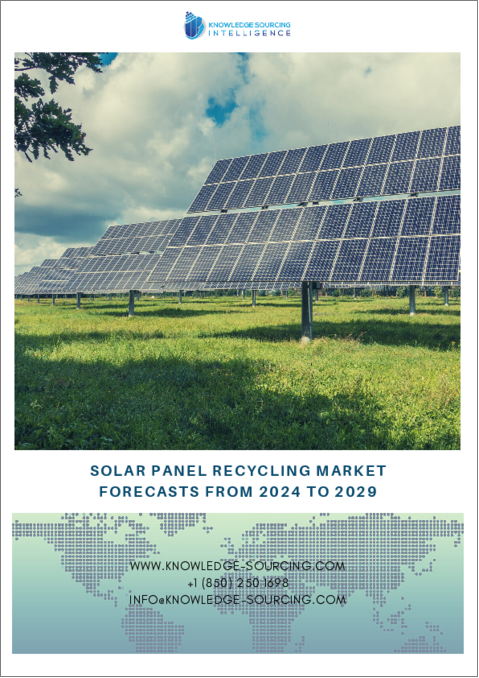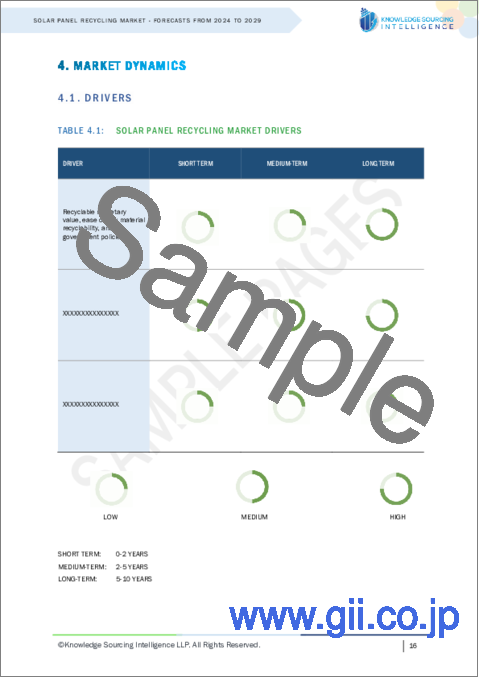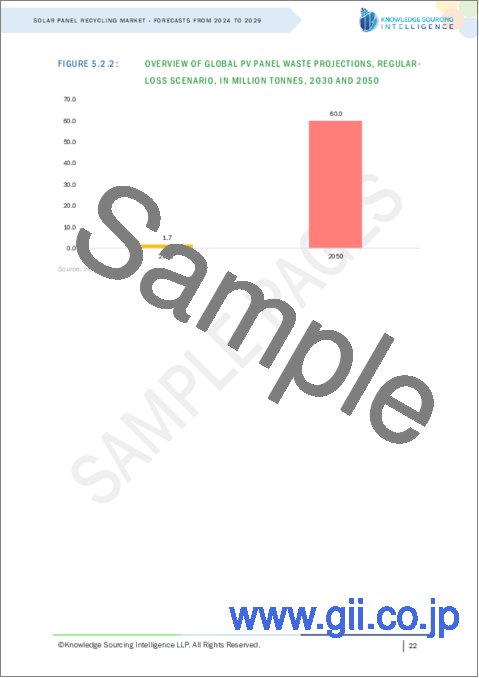|
|
市場調査レポート
商品コード
1457086
ソーラーパネルリサイクル市場 - 2024年~2029年までの予測Solar Panel Recycling Market - Forecasts from 2024 to 2029 |
||||||
|
● お客様のご希望に応じて、既存データの加工や未掲載情報(例:国別セグメント)の追加などの対応が可能です。 詳細はお問い合わせください。 |
|||||||
| ソーラーパネルリサイクル市場 - 2024年~2029年までの予測 |
|
出版日: 2024年02月09日
発行: Knowledge Sourcing Intelligence
ページ情報: 英文 124 Pages
納期: 即日から翌営業日
|
- 全表示
- 概要
- 目次
ソーラーパネルリサイクル市場は、2022年には1,802億7,700万米ドルと評価され、CAGR 27.86%で成長し、2029年には1兆773億5,600万米ドルの市場規模に達すると予測されています。
ソーラーパネルリサイクルは、廃棄された太陽光発電(PV)パネルから素子を回収し、再利用することです。再生可能エネルギー分野の持続可能性にとって不可欠です。資源の枯渇や環境破壊を避けるためには、世界中に設置された使用済み太陽光パネルの廃棄を管理することが重要です。リサイクルには通常、シリコン、アルミニウム、ガラスなど、新たな製品に再利用するための貴重な成分を抽出するための材料の収集、分類、分解、加工、精製が含まれます。
ソーラーパネルリサイクルには、廃棄物の削減、エネルギーの節約、資源の保全、経済的見通しなど、いくつかの利点があります。利害関係者は、効果的なリサイクル・インフラを整備し、倫理的な使用済み製品の管理方法を奨励することで、環境への影響を軽減しながら、太陽エネルギー分野の長期的な存続を保証することができます。
市場動向:
持続可能なエネルギー源の利点の増大に対する顧客の意識の高まりと、地方政府による補助金の支給は、太陽電池モジュールの設置数の増加と同様に、市場成長を促進する重要な要因です。ソーラーパネルの採用の増加、政府規制の強化、ソーラーパネルの効果的な廃棄の増加、他の非エコフレンドリーなエネルギー源の代替としてのソーラーパネル設置数の増加などが、ソーラーパネルリサイクル業界を牽引する主な要因です。
さらに、技術進歩の高まりや製造プロセスの近代化、業界における研究開発活動の高まりは、予測期間を通じてソーラーパネルリサイクル市場に新たな機会を提供すると予測されています。しかし、ソーラーパネルリサイクルに関する認知度の低さが、ソーラーパネルリサイクル市場成長のさらなる課題となる主要な制約となっています。
市場促進要因:
- 太陽エネルギー浪費の増加が市場成長の原動力になると予想されます。
ソーラーパネルの機能寿命は20~25年で、その後は交換が必要です。これらのソーラーパネルには、重金属を含む太陽電池モジュールが搭載されているため、埋め立て処分することはできないです。そのため、ソーラーパネルリサイクルビジネスには大きな可能性があります。ソーラーパネルは複数の部品に分解でき、機械的、熱的、化学的、レーザー的、およびそれらの組み合わせなど、さまざまな方法でリサイクルできます。
さらに、国際再生可能エネルギー機関(IRENA)によると、世界のソーラーパネル廃棄物の蓄積量は、2050年までに6,000万トンから7,800万トンに達すると予想されています。その結果、ソーラー廃棄物の増加は、世界のソーラーパネルリサイクル産業の活性化につながると予測されています。さらに、太陽エネルギーは手ごろな価格で、生態学的にも有益です。国際エネルギー機関(IRENA)によれば、太陽光発電は電力供給における新たなリーダーであり、急速な成長が見込まれています。したがって、ソーラーパネルリサイクルの需要は世界的に拡大しています。
- 太陽光発電設備の増加により、市場の拡大が加速すると予想されます。
ソーラーパネルリサイクル市場は、ソーラーパネルの設置が増加することにより、いくつかの顕著な影響を受けています。より多くの太陽光発電システムが設置されるにつれて、使用期限が近づいた太陽光発電(PV)パネルの量も増加します。より多くのパネルが使用済みとなるにつれ、その廃棄を処理し、貴重な材料を回収するための、効果的で環境に優しいリサイクル方法の必要性が高まっています。
さらに、成長する太陽光発電産業は、インフラ整備とソーラーパネルリサイクル技術の革新を促します。より多くのパネルを効率的かつ効果的に管理するため、リサイクル施設や手順が確立されています。
- 規制の強化が市場を牽引すると予想されます。
太陽光発電(PV)パネルの適切な使用期限管理のための基準や指針を定める規制は、ソーラーパネルリサイクル市場に大きな影響を与えます。拡大生産者責任(EPR)規制は、生産者に製品の回収とリサイクルの手配と資金提供を強制するもので、こうした義務付けの一部となっていることが多いです。
また、使用済みPVパネルの埋め立てを一定割合に抑えることを目的としたリサイクル目標を達成するために、リサイクルインフラや手順への投資が奨励されています。リサイクルの取り組みを促進し、コンプライアンスを容易にするためのインセンティブとして、補助金、税額控除、その他の財政支援が提供されることもあります。また、環境におけるリサイクル材料の持続可能性とその品質を保証するため、リサイクル手順に基準や認証要件を設ける規制もあります。
市場抑制要因:
- 認識と一般的関心の欠如が市場の妨げとなっています。
リサイクルは高価であり、アジア太平洋地域の新興諸国における認識と一般的関心の欠如が市場拡大の妨げになると予測されます。リサイクルは埋め立てよりもコストが高く、回収されたスクラップの価値は元のものよりも低いです。そのため、リサイクルに対する関心は低いです。ソーラーパネルリサイクルはまだ非常に高価です。とはいえ、研究者たちはこの問題を解決するために、新しいリサイクル技術を模索しています。廃棄物には、ケイ素、カルシウム、鉛、その他の有毒化合物(発がん性物質を含む)が含まれており、パネルを壊さなければ取り除くことができないです。
アジア太平洋はソーラーパネルリサイクル市場で大きなシェアを占めると予測されています。
ソーラーパネルリサイクル市場は、アジア太平洋地域で急速な拡大が見込まれています。特にアジア太平洋地域では、環境問題への関心の高まりと工業化に伴い、太陽光発電の生産能力が大きな牽引力となっています。
中国やインドといった国々は、この地域で突出した太陽光発電国であり、ソーラーパネルの設置割合が高いです。中国は、世界のソーラーパネル生産能力の約71%を製造しています。さらに、既存のインフラが老朽化していることから、ソーラーパネルリサイクル市場は予測期間中に人気を集めると予想されます。
市場開拓:
- 2023年 7月、丸紅株式会社と株式会社ハマダが新規事業として設立した株式会社レクシアが、使用済み太陽光パネルの販売、買取、処分に関するリサイクルおよびリユース関連サービスの提供を開始しました。
- 2023年 4月、エネルギー研究所@NTU(ERI@N)を通じて、太陽光発電の技術革新と世界の販路のリーダーであるMaxeon Solar Technologies, Ltd.(マクセオン・ソーラー・テクノロジーズ社)を設立した、
- 2023年3月、太陽光発電分野向けに持続可能な素材を大規模に生産することを目指す技術主導型のリサイクル企業SOLARCYCLEは、シリーズA投資で3,000万米ドルを確保したことを明らかにし、2022年の創業以来同社が調達した資金総額は3,700万米ドルに増加しました。
目次
第1章 イントロダクション
- 市場概要
- 市場の定義
- 調査範囲
- 市場セグメンテーション
- 通貨
- 前提条件
- 基準年と予測年のタイムライン
- ステークホルダーにとっての主なメリット
第2章 調査手法
- 調査デザイン
- 調査プロセス
第3章 エグゼクティブサマリー
- 主な調査結果
- アナリストビュー
第4章 市場力学
- 市場促進要因
- 市場抑制要因
- ポーターのファイブフォース分析
- 業界バリューチェーン分析
- アナリストビュー
第5章 ソーラーパネルリサイクル市場:パネルタイプ別
- イントロダクション
- シリコンベース
- 市場動向と機会
- 成長の見通し
- 地理的な収益性
- 薄膜ベース
- 市場動向と機会
- 成長の見通し
- 地理的な収益性
第6章 ソーラーパネルリサイクル市場:素材別
- イントロダクション
- ガラス
- 市場動向と機会
- 成長の見通し
- 地理的な利益性
- 金属
- 市場動向と機会
- 成長の見通し
- 地理的な収益性
- その他
- 市場動向と機会
- 成長の見通し
- 地理的な利益性
第7章 ソーラーパネルリサイクル市場:地域別
- イントロダクション
- 南北アメリカ
- 市場動向と機会
- 成長の見通し
- 地理的な収益性
- 欧州・中東・アフリカ
- 市場動向と機会
- 成長の見通し
- 地理的な利益性
- アジア太平洋
- 市場動向と機会
- 成長の見通し
- 地理的な利益性
第8章 競合環境と分析
- 主要企業と戦略分析
- 市場シェア分析
- 合併、買収、合意およびコラボレーション
- 競争力のあるダッシュボード
第9章 企業プロファイル
- Recycle Solar Technologies Ltd.
- First Solar(Leeward Renewable Energy, LLC)
- Veolia
- We Recycle Solar
- Cleanites Recycling
- NPC Incorporated
- Rinovasol
- Ballarat Solar Company
The solar panel recycling market is evaluated at US$180.277 billion for the year 2022 and is projected to grow at a CAGR of 27.86% to reach a market size of US$1,077.356 billion by the year 2029.
Solar panel recycling is the methodical collection and repurposing of elements from solar photovoltaic (PV) panels that have been retired. It is essential for sustainability in the renewable energy sector. To avoid resource depletion and environmental damage, it is critical to manage the disposal of end-of-life solar panels as these installations spread around the world. Recycling usually entails gathering, classifying, disassembling, processing, and refining materials to extract valuable components for reuse in new goods, such as silicon, aluminum, and glass.
Solar panel recycling has several advantages, including reduced waste, energy savings, resource conservation, and economic prospects. Stakeholders can guarantee the long-term viability of the solar energy sector while reducing its environmental impact by putting in place effective recycling infrastructure and encouraging ethical end-of-life management practices.
MARKET TRENDS:
Rising customer awareness of the increased benefits of sustainable energy sources, as well as subsidies provided by provincial governments, is a critical factor driving market growth, as is an increase in the number of installations of solar photovoltaic modules. Rising adoption of solar panels, rising government regulations, increasing effective disposal of solar panels, and an increase in the number of solar panel installations as an alternative to other non-eco-friendly sources are the key drivers driving the solar panel recycling industry, among others.
Furthermore, rising technological advancement and modernization in manufacturing processes, as well as rising research and development activities in the industry, are predicted to provide new opportunities for the solar panel recycling market throughout the projected period. However, a lack of awareness regarding solar panel recycling is a key restriction that would further challenge the solar panel recycling market growth.
MARKET DRIVERS:
- The rise in solar energy waste is anticipated to drive the market growth.
Solar panels have a functional life of 20 to 25 years and must be changed after that. These solar panels have photovoltaic modules which contain heavy metals and so cannot be disposed of in landfills. As a result, the solar panel recycling business has enormous potential. The solar panel can be dismantled into multiple parts and recycled using a variety of methods, including mechanical, thermal, chemical, laser, and combinations thereof.
Furthermore, the total volume of accumulated global solar panel waste is expected to reach 60 to 78 million tonnes by 2050, according to the International Renewable Energy Agency (IRENA). As a result, the rise in solar waste is projected to fuel the worldwide solar panel recycling industry. Additionally, solar energy is both affordable and ecologically beneficial. According to the International Energy Agency, solar PV is the new leader in power supply and is set for rapid growth. Hence, the global demand for solar panel recycling is growing globally.
- Increased solar installations are expected to upsurge the market expansion.
The solar panels recycling market is strongly impacted by the growing installation of solar panels in several noteworthy ways. As more solar systems are installed, there is a corresponding rise in the quantity of end-of-life photovoltaic (PV) panels that are nearing the end of their use. As more panels become retired, there is an increasing need for effective and environmentally friendly recycling methods to handle their disposal and recover valuable materials.
Additionally, the growing solar industry encourages infrastructure development and innovation in solar panel recycling technology. To efficiently and effectively manage higher numbers of panels, recycling facilities and procedures have been established.
- A rise in regulatory mandates is anticipated to drive the market.
Regulations that set standards and guidance for the proper end-of-life management of photovoltaic (PV) panels have a substantial influence on the market for solar panel recycling. Extended producer responsibility (EPR) regulations, which force producers to arrange and fund product collection and recycling, are frequently a part of these mandates.
To satisfy recycling targets, which also aim to keep a specific proportion of end-of-life PV panels out of landfills, investments in recycling infrastructure and procedures are encouraged. Grants, tax credits, and other forms of financial assistance may be offered as incentives to promote recycling initiatives and ease compliance. Regulations may also set criteria and certification requirements for recycling procedures, guaranteeing the sustainability of recycled materials in the environment and their quality.
MARKET RESTRAINTS:
- Lack of awareness and general interest hinders the market.
Recycling is expensive, and the lack of awareness and general interest in developing countries in the Asia Pacific region is predicted to hamper market expansion. Recycling is more expensive than landfilling, and the value of recovered scraps is less than the original. Thereby, there is minimal interest in recycling. Solar panel recycling is still very expensive. Nevertheless, researchers are exploring novel recycling technologies to curb this issue. The waste contains silicon, calcium, lead, and other toxic compounds (including carcinogens) that cannot be removed without breaking the panel further restraining the market.
Asia Pacific is predicted to account for a significant share of the solar panel recycling market.
The solar panel recycling market is expected to expand at a rapid rate in the Asia-Pacific region. With growing environmental concerns and industrialization, particularly in Asia-Pacific, the region's solar power-producing capacity has acquired significant traction.
Countries such as China and India are prominent solar power generating countries in the region, with a high percentage of solar panel installations. China manufactures around 71% of global solar panels capacity. Furthermore, due to the existing and aging infrastructure, the solar panel recycling market is anticipated to gain popularity during the forecast period.
Market Developments:
- In July 2023, Rexia Corporation, a new business formed by Marubeni Corporation and HAMADA Co., Ltd., began offering recycling and reuse-related services for the sale, acquisition, and disposal of used solar panels.
- In April 2023, through its Energy Research Institute @ NTU (ERI@N), Maxeon Solar Technologies, Ltd., a leader in solar innovation and channels worldwide, partnered with Nanyang Technological University, Singapore (NTU Singapore), to research ways to enhance solar recycling on Earth Day 2023.
- In March 2023, the tech-driven recycling firm SOLARCYCLE, which aims to produce sustainable materials at scale for the solar sector, revealed that it has secured $30 million in Series A investment, increasing the total amount of funding raised by the company since its founding in 2022 to $37 million.
Segmentation:
By Panel Type
- Silicon-based
- Thin film-based
By Material
- Glass
- Metal
- Others
By Geography
- Americas
- Europe Middle East and Africa
- Asia Pacific
TABLE OF CONTENTS
1. INTRODUCTION
- 1.1. Market Overview
- 1.2. Market Definition
- 1.3. Scope of the Study
- 1.4. Market Segmentation
- 1.5. Currency
- 1.6. Assumptions
- 1.7. Base, and Forecast Years Timeline
- 1.8. Key Benefits for the stakeholder
2. RESEARCH METHODOLOGY
- 2.1. Research Design
- 2.2. Research Processes
3. EXECUTIVE SUMMARY
- 3.1. Key Findings
- 3.2. Analyst View
4. MARKET DYNAMICS
- 4.1. Market Drivers
- 4.2. Market Restraints
- 4.3. Porter's Five Forces Analysis
- 4.3.1. Bargaining Power of Suppliers
- 4.3.2. Bargaining Power of Buyers
- 4.3.3. Threat of New Entrants
- 4.3.4. Threat of Substitutes
- 4.3.5. Competitive Rivalry in the Industry
- 4.4. Industry Value Chain Analysis
- 4.5. Analyst View
5. SOLAR PANEL RECYCLING MARKET, BY PANEL TYPE
- 5.1. Introduction
- 5.2. Silicon-based
- 5.2.1. Market Trends and Opportunities
- 5.2.2. Growth Prospects
- 5.2.3. Geographic Lucrativeness
- 5.3. Thin-film based
- 5.3.1. Market Trends and Opportunities
- 5.3.2. Growth Prospects
- 5.3.3. Geographic Lucrativeness
6. SOLAR PANEL RECYCLING MARKET, BY MATERIAL
- 6.1. Introduction
- 6.2. Glass
- 6.2.1. Market Trends and Opportunities
- 6.2.2. Growth Prospects
- 6.2.3. Geographic Lucrativeness
- 6.3. Metal
- 6.3.1. Market Trends and Opportunities
- 6.3.2. Growth Prospects
- 6.3.3. Geographic Lucrativeness
- 6.4. Others
- 6.4.1. Market Trends and Opportunities
- 6.4.2. Growth Prospects
- 6.4.3. Geographic Lucrativeness
7. SOLAR PANEL RECYCLING MARKET, BY GEOGRAPHY
- 7.1. Introduction
- 7.2. Americas
- 7.2.1. Market Trends and Opportunities
- 7.2.2. Growth Prospects
- 7.2.3. Geographic Lucrativeness
- 7.3. Europe Middle East and Africa
- 7.3.1. Market Trends and Opportunities
- 7.3.2. Growth Prospects
- 7.3.3. Geographic Lucrativeness
- 7.4. Asia Pacific
- 7.4.1. Market Trends and Opportunities
- 7.4.2. Growth Prospects
- 7.4.3. Geographic Lucrativeness
8. COMPETITIVE ENVIRONMENT AND ANALYSIS
- 8.1. Major Players and Strategy Analysis
- 8.2. Market Share Analysis
- 8.3. Mergers, Acquisitions, Agreements, and Collaborations
- 8.4. Competitive Dashboard
9. COMPANY PROFILES
- 9.1. Recycle Solar Technologies Ltd.
- 9.2. First Solar (Leeward Renewable Energy, LLC)
- 9.3. Veolia
- 9.4. We Recycle Solar
- 9.5. Cleanites Recycling
- 9.6. NPC Incorporated
- 9.7. Rinovasol
- 9.8. Ballarat Solar Company




